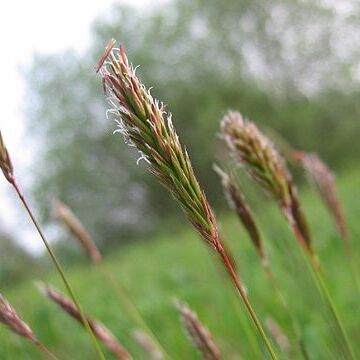Annuals or perennials with aromatic (coumarin-scented) shoots, caespitose to decumbent, bisexual. Leaves: ligule an unfringed membrane; blade rolled in bud. Inflorescences dense many-flowered spike-like racemes or panicles, with axes ending in spikelets. Spikelets sessile 1 3 Marrakai Street, Hawker, Australian Capital Territory 2614. to pedicellate, laterally compressed, disarticulating above glumes, with 3 florets, the 2 lower florets sterile and 1 bisexual floret terminating rachilla. Glumes 2, very unequal, awnless, membranous and ±shining, keeled; lower glume 1-nerved; upper glume much longer than lemmas, 3-nerved. Sterile florets: lemma longer than bisexual floret, emarginate, 1-awned, 3-nerved. Bisexual floret: lemma entire, awnless (in Australia) or with 1 geniculate awn, becoming indurated, dorsally rounded, 1–7-nerved; palea rounded on back; lodicules absent; stamens 2 or rarely 3. Caryopsis: hilum short; embryo small.
Perennials or annuals, ± fragrant with coumarin. Leaf-sheath rounded. Ligule membranous. Leaf-blade flat, usually ± flaccid. Culm slender. Panicle narrow, spike-like. Spikelets with 3 florets, the lower 2 Ø or rarely ♂, the third much shorter, ☿, protogynous; disarticulation above glumes; rachilla not prolonged. Glumes unequal with the lower shorter, membranous, 1-3-nerved, keeled. Lemmas of Ø florets equal, keeled, hairy, dorsally awned; lemma of ☿ floret hyaline, 1-7-Anthoxanthum L. nerved. Palea 1-nerved. Lodicules 0. Stamens 2 in ☿ florets, sometimes 3 in ♂ florets. Ovary glabrous; styles free. Caryopsis terete; embryo ¼ length of caryopsis; hilum punctiform or shortly elliptic; endosperm solid.
Annuals or perennials. Panicles contracted, spike-like. Spikelets 3-flowered, the 2 lowest florets reduced to sterile (rarely ♂) lemmas, the uppermost hermaphrodite; rhachilla disarticulating above the glumes, not, or scarcely, produced; glumes membranous with hyaline margins, the upper as long as the spikelet, the lower about half as long; sterile lemmas narrowly oblong, brown, hairy, bilobed, the lower with a short straight awn from above the middle of the back, the upper with a geniculate awn from below the middle; fertile lemma rotund, shorter than the sterile lemmas, cartilaginous; palea as long as the lemma, 1-nerved; stamens 2; stigmas 2, pubescent.
The first and second lemmas similar and almost equal, membranous, narrowly oblong in profile, 5-7-nerved, strongly laterally compressed, keeled, densely pilose, 2-fid to deeply 2-lobed, awned from the base or from the back or from the sinus; the awns usually unequal, that of the first lemma usually short and inserted 1/3-1/2-way below the apex, usually straight; that of the second lemma as long as or longer than its body, inserted near the base or sometimes around the middle, geniculate.
Glumes 2, unequal, persistent, keeled, membranous, 1-3-nerved with the nerves usually prominent, apex acute to acuminate; the inferior about 3/5-3/4 the length of the superior; the superior as long as or longer than the body of the lemmas.
Spikelets solitary, pedicelled, moderately laterally compressed, usually 3-flowered (rarely less), awned; rhachilla disarticulating above the superior glume, not produced beyond the uppermost floret.
Paleas of the first and second floret, when present, slightly shorter than the lemmas, linear, hyaline, 2-keeled; the one of the terminal floret narrowly oblong, 2-keeled, usually 1-nerved.
Terminal lemma muticous, much shorter than (1/3-1/2) the preceding ones, expanded broadly elliptic or ovate-elliptic, faintly 7-1-nerved, obtusely 2-keeled, thinly membranous.
Florets heteromorphous, the first and second sterile or male (sometimes the first male and the second sterile), the terminal one always bisexual.
Caryopsis oblong-elliptic in outline, slightly laterally compressed; embryo c. 1/4 the length of the caryopsis; hilum small, punctiform, basal.
Ovary glabrous; styles distinct, long; stigmas long, rather slender, plumose, exserted from the apex.
Sweet-scented annuals or perennials, often stoloniferous.
Stamens 3 in the male, 2 in the bisexual florets.
Inflorescence a dense spike-like panicle.
Ligules membranous.
Lodicules absent.

